35mm Lenses on the Fujifilm GFX 50S tested by Andy King
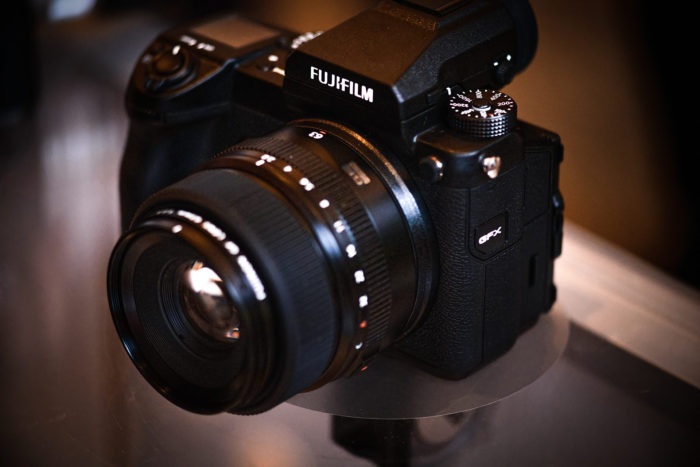
The following article is a guest post from Andy King and was first posted on akpo.ca (text and images reposted with permission). Andy tested a set of Full Frame lenses on the GFX. And the results are surprising as most of these lenses do work just fine on the GFX!
35mm Lenses on the Fujifilm GFX 50S
by Andy King
At Photokina 2016, Fujifilm shocked the photographic industry by announcing the production of the GFX 50S, a mirrorless medium format digital camera with a redesigned 44x33mm CMOS sensor. Unlike the Hasselblad X1D that was announced months prior, the GFX 50S sported both a focal-plane shutter and full electronic shutter. This game-changing feature meant that users could use any of their vintage medium format lenses onto the GFX 50S; the G mount system was now open to the vast ocean of lenses from the 19th century and onwards.
The design of a lens, focal length of a lens, aperture, number of elements, focus distance, default flange distance, size of the front and rear elements all contribute to the size of the image circle projected by the lens. A telephoto portrait lens with a large aperture would have relatively wide front and rear elements; resulting in a bigger image circle than the image format it was designed for. We can apply this knowledge to say that many 35mm lenses will cover the 44x33mm format of the GFX 50S.
In order to test out this theory, I had to first find a way to adapt 35mm lenses onto the GFX 50S. Being a mirrorless camera, the flange distance of the GFX 50S is a short 26.7mm. Canon EF lenses have a much longer flange distance of 44.0mm, meaning that if one creates an adapter wih a length of 17.3mm (the difference in flange), the adapted Canon EF lenses would retain the same focusing range on the GFX 50S as it would on any Canon EOS body (including the ability for infinity focus). Using the mount specifications of a GFX 50S brochure, I was able to 3D-print a prototype EF to G-mount adapter at the local library.
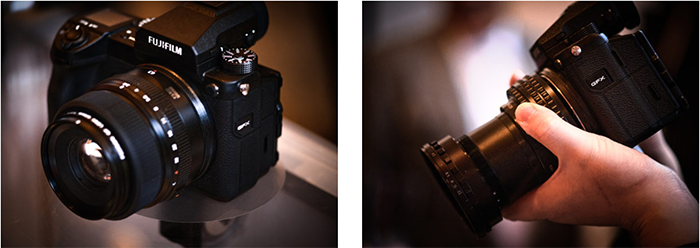
You may ask why anybody would use a lens designed for 35mm on a slightly larger imaging sensor (GFX 50S). The main reasons are image quality and artistic choice. Smaller format lenses are generally designed to resolve more detail than larger format lenses. All the tilt-shift 35mm lenses would cover the 44x33mm format, with room to spare for movements. A landscape or architecture photographer can use the shift feature to correct for perspective distortion, or for DoF control using tilt. 35mm lenses tend to have large apertures from f/0.95 and onwards, meaning they can be used for low light photography, or images with extremely thin DoF (portraiture, for example). The result of putting a 35mm portrait lens onto the GFX 50S may be swirly or soft corners, but many vintage and modern lenses are able to resolve the extreme corners of larger sensor quite well.
We tend to be inspired by medium and large format film photography for the unique and shallow DoF look. A Pentax 67 with a Takumar 105mm f/2.4 has a DoF equivalence of a 53mm f/1.2 lens on a 35mm camera (digital full-frame or film). The infamous Aero Ektar 178mm f/2.5 on 4×5? has a 35mm DoF equivalence of 52mm f/0.7. To get a similar DoF equivalence, we would have to use a Zeiss/Jena Biotar 75mm f/1.5 on the GFX 50S (35mm DoF equivalence: 59mm f/1.2). We can assume that using large-aperture (f/0.95, f/1.2, f/1.4) lenses on the GFX 50S will allow us to get similar DoF equivalences of the 67 and large format cameras. By capturing more of the image circle drawn by a lens, we also capture more of the edge aberrations (distortion, cat’s eye bokeh, swirling, etc) of a lens and thus it’s unique rendering characteristics. The artistic choices we have as digital photographers are now endless.
Downtown Camera and Aden Camera organized events for interested photographers to try out the GFX 50S. I decided to bring the prototype adapter with the Sigma 85mm f/1.4, Canon 135mm f/2.0L, Canon 24mm f/3.5TS-Eii, and a Porst 50mm f/1.7 macro. The first demo day at Downtown Camera proved that my adapter couldn’t fit inside the G-mount, so I made some revisions and tried the lenses again at Aden Camera’s demo. The Sigma 85/1.4 covered the entire 44x33mm sensor with no noticeable vignetting, including infinity focus. Similarly, the Canon 24/3.5 had no noticeable vignetting at infinity, and the only vignetting appeared at full vertical shift. I noticed that there was a color shift (fixable with WB settings) in the image with extreme shift. The Canon 135/2.0 had vignetting at infinity and distant portrait distances, but the vignetting disappeared upon focusing to five meters or closer.

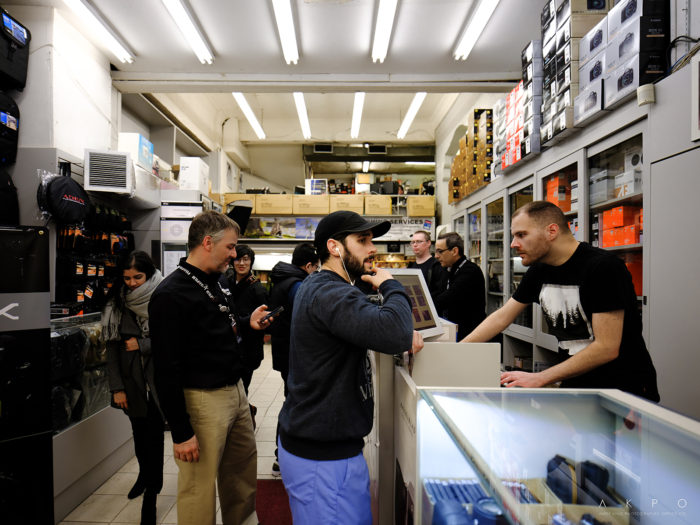
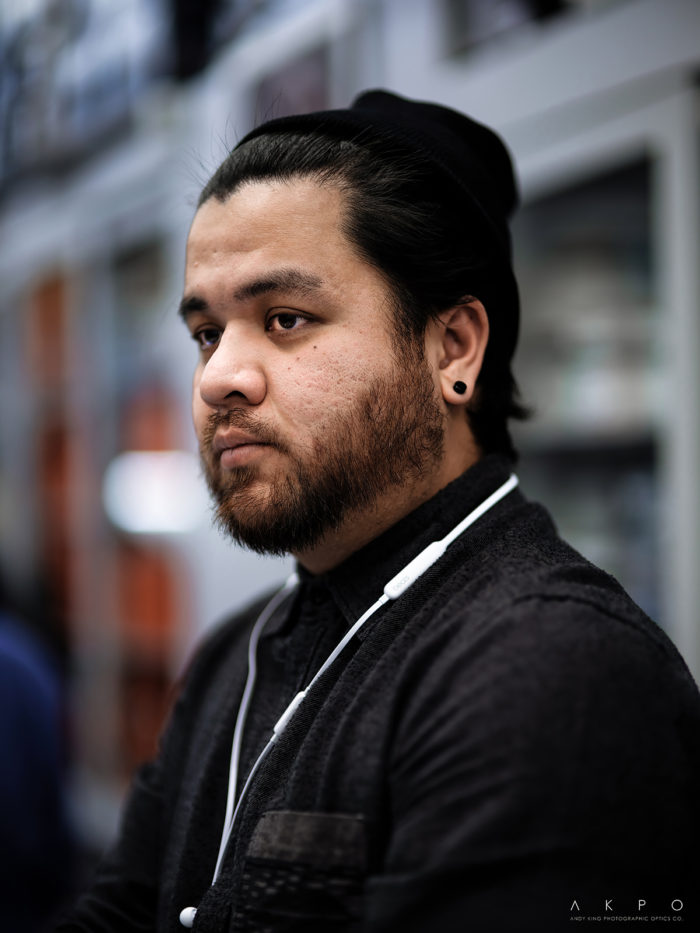
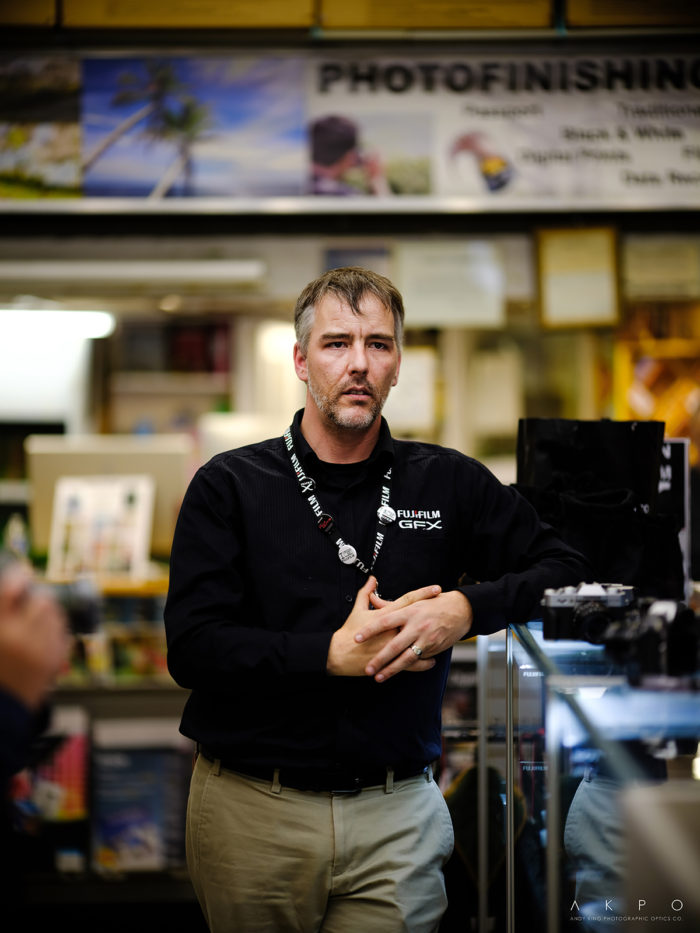
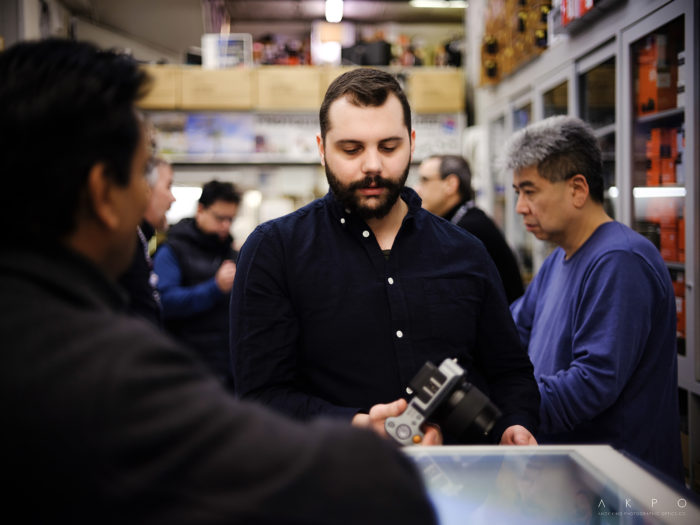
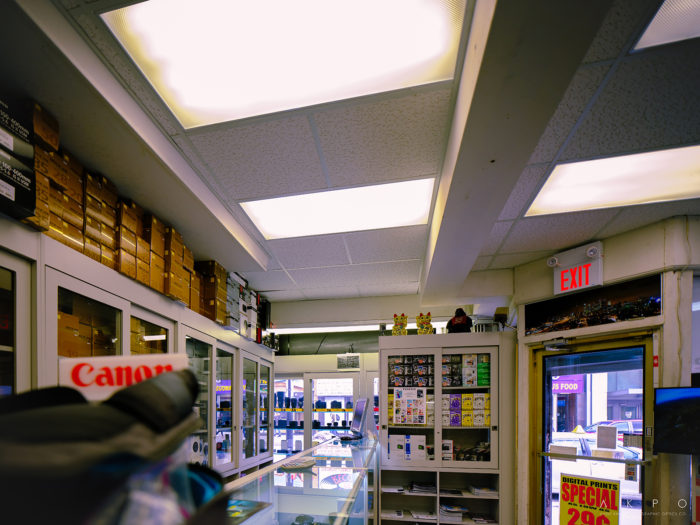
I would like to give a big thanks to Fujifilm Canada, as well as Downtown Camera and Aden Camera in Toronto, for letting us try out the GFX 50S and allowing me conduct this test.
Download All images (Zip file)
–
Fuji GFX at BHphoto, Amazon and at Calumet Germany.
Fuji says next generation of mirrorless cameras will beat DSLRs in every respect!

Dpreview interviewed Mr. Toshihisa Iida from Fuji. One of his most interesting statements is this:
“Maybe one more processor and sensor generation should be enough to make mirrorless beat DSLRs in every respect.”
That would be nice!
And here are a few interesting bits about the GFX which will start shipping out next week at BHphoto, Amazon and at Calumet Germany:
GFX camera release cycle: “Obviously the sales volume will be lower, so the product life cycle will probably be longer. But whenever we have the right combination of the right hardware, the right sensor and the right processor, we’ll introduce a new camera.”
Future lenses: “A lot of photographers are asking us for telephoto lenses, in the 200-300mm range. Nature photographers for example. Also people are asking for a wide-angle, like a 15mm equivalent, and an equivalent to the 70-200mm on full-frame.“
Press text: SD association doubles bus interface speeds with UHS-iii
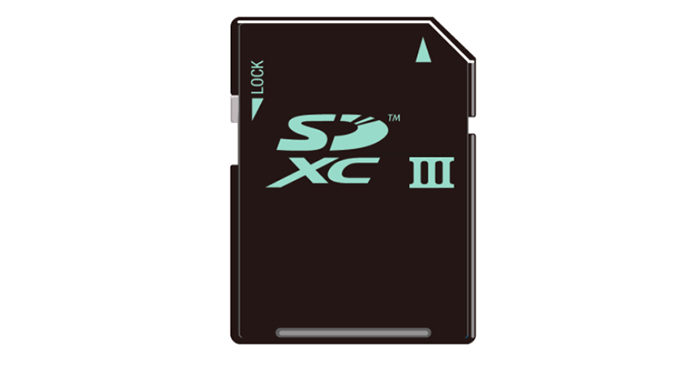
The SD association announced a newUHS-III card standard. It allows up to 624 MB/sec transfer ratem which is ideal for 8K and 360 degree video recording. Here is the full original press text:
SD ASSOCIATION DOUBLES BUS INTERFACE SPEEDS WITH UHS-III
624 MB/sec transfer rate makes quick work of high-quality camera images,
360-degree, virtual reality and 4K and 8K video applications
Pacifico Yokohama, Japan — CP+ Camera and Photo Imaging Show Booth # G-16 —
Feb. 22, 2017 — The SD Association announced today UHS-III, doubling the fastest
SD memory card transfer rate up to 624 megabytes per second (MB/s). UHS-III faster
speeds help move large amounts of data generated by data-intense Gbps wireless
communication, 360-degree cameras, drones, 3D, 4K and 8K videos recorded on
SDXC and SDHC memory cards.Mirrorlessrumors.com
Immense storage capacities introduced with SDXC memory cards give users the ability
to take more pictures and make unique video features on the latest imaging devices.
Fast UHS bus interfaces help users manage that content more quickly. Since it is fully
backwards compatible, devices offering UHS-III bus interface will accept the billions of
existing SD memory cards in the market today.
“SD memory card capabilities continue to expand, paving the way for new and highly
anticipated imaging and video features, from virtual reality to 8K video,” said Brian
Kumagai, SDA president. “The SDA remains committed to supporting innovation by
consumer electronics manufacturers and to delivering the same performance and
interoperability consumers and professional users love about SD memory cards.”
The SDA released a visual mark to denote UHS-III SD memory cards for easy
matching with devices’ recommendation for the best SD memory card for optimal
performance.
SDXC UHS-III card example:
UHS Bus InterfaceMirrorlessrumors.com
The UHS-III high-speed interface signals are assigned to the second row of SD
memory card pins introduced with UHS-II. This newest bus transfer speed option will be
available in full-size SDHC and SDXC cards, as well as microSDHC and microSDXC
cards. It does not change the physical size or shape of the cards as the move from
UHS-II to UHS-III involves only a PHY change, allowing relatively easy and fast
upgrades of existing UHS-II products to UHS-III.
Both UHS-I and UHS-II make the robust storage specified for SDHC and SDXC
manageable and even more portable. Ultra High Speed was announced in June 2010
with UHS-I delivering top bus-interface speeds of 104 MB/sec, which was tripled to 312
MB/sec in UHS-II. UHS bus interfaces are backwards compatible and are exclusive to
SDXC and SDHC products. All UHS-equipped memory cards achieve greatest
performance when paired with corresponding UHS devices. SDXC and SDHC UHS-I
and UHS-II products are already in retail outlets around the world and supported by
leading camera manufacturers. You can read more about UHS on our website.
Find the SD Association at CP+ Camera and Photo Imaging Show in Booth MR-16,
February 23-26, 2017, in Pacifico Yokohama, Japan.
SD Association
The SD Association is a global ecosystem of nearly 900 technology companies charged
with setting interoperable SD standards. The Association encourages the development
of consumer electronic, wireless communication, digital imaging and networking
products that utilize market-leading SD technology. The SD standard is the number one
choice for consumers and has earned more than 80 percent of the memory card market
with its reliable interoperability and its easy-to-use format. Today, smart phones, tablets,
Blu-ray players, HDTVs, audio players, automotive multimedia systems, handheld PCs,
digital cameras and digital video cameras feature SD interoperability. For more
information about SDA or to join, please visit the Association’s website,
https://www.sdcard.org.
SD Logos are trademarks licensed by SD-3C LLC.
Zeiss will display a new Batis (135mm???) tele portrait lens at “The Photography Show” in Birmingham

Zeiss will soon announce a new Batis FE lens which could have a focal length of 135mm. We got no info about the announcement date but I think it will be announced before the Birmingham photo show…
MFT news: New 90mm macro lens from Kowa and first Panasonic 8-18mm hands-on
Let’s catch up with two Micro Four Thirds news:
1) Fujiyacamera shared the image of the new Kowa 90mm f/2.5 macro lens:
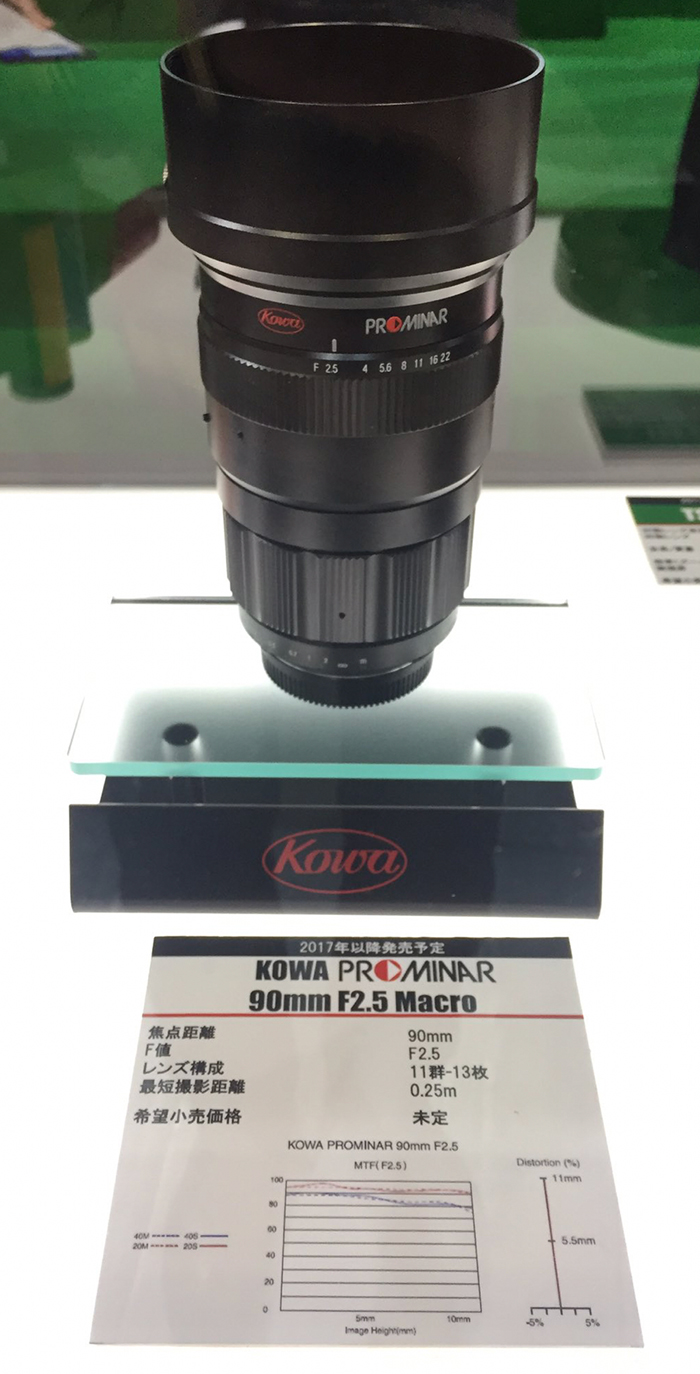
2) And Giulio Sciorio posted that Panasonic Leica 8-18mm hands-on video (UPDATE: Giulio removed the video!)
Cosina Japan announced the development of three new Sony E-mount lenses

The Voigtländer MACRO APO-LANTHAR 65mm F2 Aspherical was announced at Photokina 2016 in Cologne, Germany, as a reference exhibit. Since then specifications and appearance have been improved.
The Red, Green, and Blue lines on the lens barrel proudly indicate its heritage from vintage APO-LANTHAR lens designs – High Performance.
At F2, this lens is one of the fastest macro lenses available for full frame format. SAR
Macro Ratio is 1:2. Minimum Object Distance is 31cm.

NOKTON 40mm F1.2 Aspherical is the fastest 40mm lens ever made for the Full Frame format sensor. This lens is compact enough but also can produce high resolution picture due to the lens construction design optimized for Full Frame E-mount sensor.
Minimum Object Distance is 40cm. Selective Aperture Control System is available.

We re-design the lens construction of M-mount version, which is now optimized for Full Frame E-mount sensor. As NOKTON Classic 35mm F1.4 has the “Classic” in its name, this lens produce beautiful Bokeh at wide open, and sharp image at stop down.
